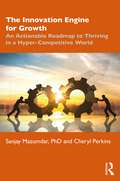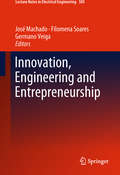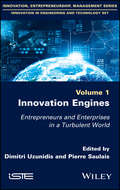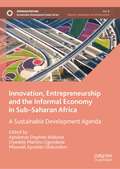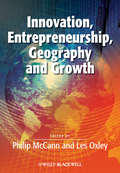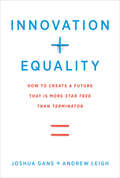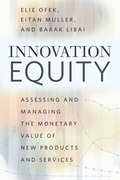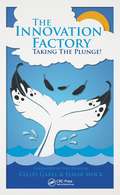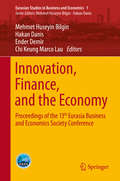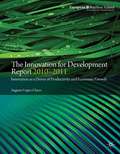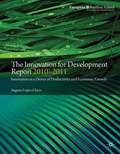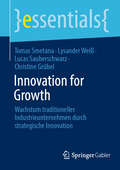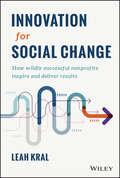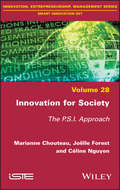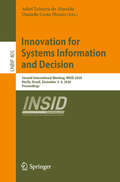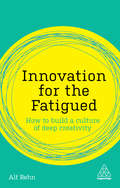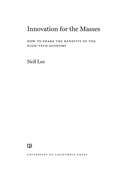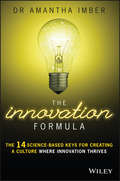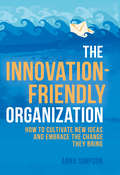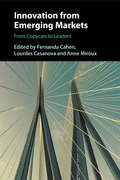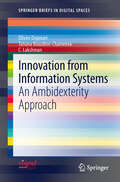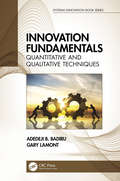- Table View
- List View
The Innovation Engine for Growth: An Actionable Roadmap to Thriving in a Hyper-Competitive World
by Sanjay Mazumdar Cheryl PerkinsWritten by experts on innovation and growth, this book provides the necessary tools to systematically develop and sustain profitable innovation pipelines. In a hypercompetitive global market, businesses must innovate to survive; yet the failure rate for innovation is extremely high. Strategists and thought leaders, Cheryl Perkins and Dr. Sanjay Mazumdar, offer a sophisticated yet practical approach for implementing successful innovation. Leveraging thought-provoking questions and powerful templates, the book outlines how companies can leverage core strengths, build internal innovation capabilities, partner effectively, and identify the promising areas to pursue. In addition, the book highlights emerging innovations in several major industries, providing fodder to fuel creative thinking and exploration of possible applications across a variety of different industries. Managers and leaders will welcome the innovation insights and examples, as well as the templates to build an organization’s plan to diagnose patterns of innovation, identify opportunities, and apply emerging innovations in their own industries and businesses.
Innovation, Engineering and Entrepreneurship (Lecture Notes in Electrical Engineering #505)
by José Machado Filomena Soares Germano VeigaThis book presents endeavors to join synergies in order to create added value for society, using the latest scientific knowledge to boost technology transfer from academia to industry. It potentiates the foundations for the creation of knowledge- and entrepreneurial cooperation networks involving engineering, innovation, and entrepreneurship stakeholders. The Regional HELIX 2018 conference was organized at the University of Minho’s School of Engineering by the MEtRICs and Algoritmi Research Centers, and took place in Guimarães, Portugal, from June 27th to 29th, 2018. After a rigorous peer-review process, 160 were accepted for publication, covering a wide range of topics, including Control, Automation and Robotics; Mechatronics Design, Medical Devices and Wellbeing; Cyber-Physical Systems, IoT and Industry 4.0; Innovations in Industrial Context and Advanced Manufacturing; New Trends in Mechanical Systems Development; Advanced Materials and Innovative Applications; Waste to Energy and Sustainable Environment; Operational Research and Industrial Mathematics; Innovation and Collaborative Arrangements; Entrepreneurship and Internationalization; and Oriented Education for Innovation, Engineering and/or Entrepreneurship.
Innovation Engines: Entrepreneurs and Enterprises in a Turbulent World
by Dimitri Uzunidis Pierre SaulaisIn an uncertain economy where business risk is significant, the company tends to rely more on its environment than to invest, for example, in all steps of technological creation; This can be explained by the fact that investments in the acquisition (ownership) of production resources are less expensive than those implied in the formation of these resources; which also explains the attractiveness (in an open economy) of regions with abundant scientific and technical resources. To understand and analyze the innovation process in order to better design and launch new goods, services and technologies, one has to consider the creative dimension of the individual, the business and the organization in general. In new approaches to innovation, the entrepreneur and the company are analyzed through their skills, and their function of resource generation; Innovation thus becomes endogenous, gradual or radical, integrated in a complex process with many feedbacks and interactions. The innovative organization (small or large) is presented in this book as a dynamic system composed of specific and diverse skills (including those of the contractor, engineers or managers). By acquiring, combining and mobilizing these skills, the innovative agent (entrepreneur or company) can create technological resources and develop relations with its environment. Hence the importance of management in design, implementation, protection of intellectual property as well as of the development of new goods, services and technology, commercial and organizational models.
Innovation, Entrepreneurship and the Informal Economy in Sub–Saharan Africa: A Sustainable Development Agenda (Sustainable Development Goals Series)
by Ayodotun Stephen Ibidunni Oyedele Martins Ogundana Maxwell Ayodele OlokundunSet against the backdrop of a rising population in Africa and the lowering opportunities for white collar jobs, as well as the continent’s limited access to resources, this edited collection demystifies the interconnectedness between the factors and actors involved with innovation and entrepreneurship development in sub-Saharan Africa’s (SSA) informal economy for more effective, result-oriented outcomes.Exposing the underlying motivations that define uniqueness in Africa’s innovation and entrepreneurship ecosystem, particularly in the informal sector, the editors argue that there is a significant knowledge gap that this book seeks to fill, concerning institutionalization, motivational factors and the harnessing of the innovative potentials of Africa’s informal sector entrepreneurs and their supporting role in achieving a more sustainable African regionBy identifying patterns of domesticating entrepreneurship theories and showcasing the latest research, the book covers awide array of topics that discuss a multidisciplinary and multicultural perspective to entrepreneurship theory and practices in Africa. In this way the book contributes to the goals of SDG 9 ('Build resilient infrastructure, promote inclusive and sustainable industrialization and foster innovation') in Africa.
Innovation, Entrepreneurship, Geography and Growth (Surveys of Recent Research in Economics)
by Philip McCann Les OxleyInnovation, Entrepreneurship, Geography and Growth provides a timely, accessible review of our understanding of the complex links between innovation, entrepreneurship, geography and growth. Expert contributions provide a thorough roadmap of the developments in research at the interface of these themes. A timely and accessible review of our understanding of the complex links between innovation, entrepreneurship, geography and growth A highly comprehensive roadmap of the range of issues addressed by research in these areas Discusses the most profitable ways forward for enhancing our understanding of arising issues Contributions from leading experts in the field take a variety of theoretical, empirical and institutional angles
Innovation + Equality: How to Create a Future That Is More Star Trek Than Terminator (The\mit Press Ser.)
by Joshua Gans Andrew LeighHow to get more innovation and more equality.Is economic inequality the price we pay for innovation? The amazing technological advances of the last two decades—in such areas as artificial intelligence, genetics, and materials—have benefited society collectively and rewarded innovators handsomely: we get cool smartphones and technology moguls become billionaires. This contributes to a growing wealth gap; in the United States; the wealth controlled by the top 0.1 percent of households equals that of the bottom ninety percent. Is this the inevitable cost of an innovation-driven economy? Economist Joshua Gans and policy maker Andrew Leigh make the case that pursuing innovation does not mean giving up on equality—precisely the opposite. In this book, they outline ways that society can become both more entrepreneurial and more egalitarian. All innovation entails uncertainty; there's no way to predict which new technologies will catch on. Therefore, Gans and Leigh argue, rather than betting on the future of particular professions, we should consider policies that embrace uncertainty and protect people from unfavorable outcomes. To this end, they suggest policies that promote both innovation and equality. If we encourage innovation in the right way, our future can look more like the cheerful techno-utopia of Star Trek than the dark techno-dystopia of The Terminator.
Innovation Equity: Assessing and Managing the Monetary Value of New Products and Services
by Barak Libai Elie Ofek Eitan MullerFrom drones to wearable technology to Hyperloop pods that can potentially travel more than seven hundred miles per hour, we're fascinated with new products and technologies that seem to come straight out of science fiction. But, innovations are not only fascinating, they're polarizing, as, all too quickly, skepticism regarding their commercial viability starts to creep in. And while fortunes depend on people's ability to properly assess their prospects for success, no one can really agree on how to do it, especially for truly radical new products and services. In Innovation Equity, Elie Ofek, Eitan Muller, and Barak Libai analyze how a vast array of past innovations performed in the marketplace--from their launch to the moment they became everyday products to the phase where consumers moved on to the "next big thing." They identify key patterns in how consumers adopt innovations and integrate these with marketing scholarship on how companies manage their customer base by attracting new customers, keeping current customers satisfied, and preventing customers from switching to competitors' products and services. In doing so, the authors produce concrete models that powerfully predict how the marketplace will respond to innovations, providing a much more authoritative way to estimate their potential monetary value, as well as a framework for making it possible to achieve that value.
The Innovation Factory
by Gilles Garel Elmar MockThe Innovation Factory takes a fresh look at the fine art of breakthrough innovation. What makes it unique is that it brings together an experienced scholar and a serial entrepreneur who share the same passion for understanding the processes and theories needed to innovate over and over again. The book marries theory with practical examples focusin
Innovation Finance and Technology Transfer: Funding Proof-of-Concept (Routledge Studies in Innovation, Organizations and Technology)
by Andrea AlunniOffering proof-of-concept (POC) to inventors is often a difficult task for most Technology Transfer Offices (TTOs). Through an in-depth analysis of 15 years of IP portfolio management by Oxford University Innovation (OUI), this book identifies the salient aspects of the technology transfer evolution and the role that technology transfer managers (TTMs) play in closing the gap between academia and business. Innovation Finance and Technology Transfer: Funding Proof of Concept seeks to prove that a well-managed POC Fund can achieve positive financial results and that the chances for an IP portfolio management to be "in the money" increases if the TTO is attached to an entrepreneurial University. This work illustrates how innovation based on Intellectual Property Rights protected and managed by a highly-skilled group of technology transfer managers succeeds in technology transfer. It offers a vademecum to practitioners to follow a step by step best practice procedure embraced by the Oxford TTO to manage the POC investment process. This book is valuable reading for intellectual property scholars, business school students, social sciences researchers, investment professionals and technology transfer practitioners, as well as those working in innovation think tanks and policy circles.
Innovation, Finance, and the Economy
by Mehmet Huseyin Bilgin Hakan Danis Ender Demir Chi Keung Marco LauThe first volume of the Eurasian Studies in Business and Economics, the official proceedings series of the Eurasia Business and Economics Society (EBES), includes selected papers from the 13th EBES Conference held in Istanbul in 2014. This volume covers theoretical and empirical contributions in the areas of innovation, entrepreneurship, HR, banking and finance. An eclectic set of methodologies and contributions from experts across the World makes this volume a valued work of reference. This volume also provides a timely opportunity to colleagues, professionals and students to catch up with the most recent studies in different fields and empirical findings on many countries and regions.
The Innovation for Development Report 2010–2011: Innovation as a Driver of Productivity and Economic Growth
by A. López-ClarosThis report provides a comprehensive look at the role of innovation in promoting economic and social development. It examines the impact of innovation on the economic growth of developing countries and the future role of technological innovation in international efforts to mitigate the effects of climate change, amongst many other issues.
The Innovation for Development Report 2010—2011
by Augusto López-ClarosThis report provides a comprehensive look at the role of innovation in promoting economic and social development. It examines the impact of innovation on the economic growth of developing countries and the future role of technological innovation in international efforts to mitigate the effects of climate change, amongst many other issues.
Innovation for Growth: Wachstum traditioneller Industrieunternehmen durch strategische Innovation (essentials)
by Tomas Smetana Lysander Weiß Lucas Sauberschwarz Christine GrübelDigitalisierung, Nachhaltigkeit, globaler Wettbewerb und geopolitische Rahmenbedingungen stellen traditionelle Industrieunternehmen vor neue Herausforderungen. Um diese mit der Identifizierung, Entwicklung und Realisierung passender Geschäftspotenziale erfolgreich zu adressieren, braucht es strategische Innovation. Wissenschaftlich fundiert und mit zahlreichen Praxisbeispielen erläutert dieses Buch die dazu notwendigen dynamischen Fähigkeiten für Organisationen und zeigt einen systematischen Ansatz, um diese zu etablieren und anzuwenden. Für Entscheidungsträger dient das Werk zugleich als Weckruf und Lösung, um im hochdynamischen Marktumfeld des 21. Jahrhunderts dauerhaft erfolgreich zu sein.
Innovation for Social Change: How Wildly Successful Nonprofits Inspire and Deliver Results
by Leah KralTransform your nonprofit&’s ability to innovate for the future In Innovation for Social Change, distinguished author Leah Kral delivers a practical manual for nonprofits and charitable organizations seeking to innovate their way toward new and exciting possibilities. In the book, you&’ll explore hands-on design thinking strategies and techniques you can use as a disciplined process for exploring what&’s possible in your organization. You&’ll learn how to identify hidden needs, deal with the knock-on effects of your ideas, and focus your efforts where they can have the most impact. You&’ll also discover how to transform your ideas into action, building small experiments and learning from them before scaling them up organization-wide, and how to create an ecosystem for everyday innovation. Finally, the author explains what we can learn from social entrepreneurs as they boldly challenge the status quo. The book also includes: Six basic and mutually reinforcing principles that will help you become more innovative today Instructive and engaging case studies from nonprofits with a variety of missions, visions, and political backgrounds Strategies for applying straightforward principles from economics to supercharge nonprofit innovationA can&’t-miss roadmap to creative innovation, Innovation for Social Change will earn a place in the libraries of nonprofit board members, managers, fundraisers, and other professionals in the charitable space.
Innovation for Society: The P.S.I. Approach
by Marianne Chouteau Joelle Forest Céline NguyenIn a context marked by unprecedented challenges (the struggle against inequalities, climate change, etc.), innovation appears to be the readymade universal scapegoat. Innovation for Society, however, suggests that we look at innovation differently, by inviting us to innovate with consciousness. To do this, the authors introduce an approach they call Penser le Sens de l’Innovation (P.S.I., or “thinking about the meaning of innovation”), comprising a set of tools largely from the humanities and social sciences (observation, cartography, creativity, storytelling, etc.) to lead us to this “meaning”. By considering the question of “meaning” from the point of view of both direction and signification, the authors rehabilitate the eminently political question of knowing which innovations we choose for which societies.
Innovation for Systems Information and Decision: Second International Meeting, INSID 2020, Recife, Brazil, December 2–4, 2020, Proceedings (Lecture Notes in Business Information Processing #405)
by Adiel Teixeira de Almeida Danielle Costa MoraisThis book constitutes the refereed proceedings of the Second International Meeting on Innovation for Systems Information and Decision meeting, INSID 2020, held in Recife, Brazil, in December 2020. Due to the COVID-19 pandemic the conference was held virtually. The 8 papers presented in this volume were carefully reviewed and selected from a total of 84 submissions to the main conference. The selected papers reflect methodological improvements and advances in Multicriteria Decision-Making/Multicriteria Decision-Aid (MCDM/MCDA) oriented toward real-world applications and contribute to the understanding of relevant developments of current research on and future trends of Innovation for Systems Information and Decision.
Innovation for Systems Information and Decision: Third Innovation for Systems Information and Decision Meeting, INSID 2021, Virtual Event, December 1–3, 2021, Proceedings (Lecture Notes in Business Information Processing #435)
by Adiel Teixeira de Almeida Danielle Costa MoraisThis book constitutes the refereed proceedings of the Third International Meeting on Innovation for Systems Information and Decision, INSID 2021, which was held during December 1-3, 2021. The conference was initially planned to take place in Recife, Brazil, but changed to a virtual meeting due to the COVID-19 pandemic. The 9 full papers presented in this volume were carefully reviewed and selected from a total of 76 submissions. They reflect methodological improvements and advances in multi-criteria decision-making/multi-criteria decision-aid (MCDM/MCDA) oriented toward real-world applications, which contribute to the understanding of relevant developments of current research on and future trends of innovation for systems information and decision.
Innovation for the Fatigued: How to Build a Culture of Deep Creativity (Kogan Page Inspire Ser.)
by Alf RehnHow many presentations on innovation have there been recently? Thousands? Millions? We are experiencing 'innovation fatigue': we feel cheated by the endless rounds of consultants who come into our organizations, deliver conceptual models that don't stick with the realities of business and then leave again. Companies and teams are left feeling more deflated than before, and with not one idea that's impacted the bottom line. Innovation for the Fatigued argues it is worth fighting for the concept and study of innovation in organizations.Business leaders are always looking over their shoulders for the next Uber moment to overtake them, and they recognize that innovation needs to be a top priority. But how does one innovate? This book is the antidote to the empty promises that pervade the innovation industry. By designing a company culture that nurtures ideas, but also defends against incrementalism and fads, we can rediscover the powerful basics of imagination, empathy, play and courage, which are all instrumental in delivering real impactful innovation. Innovation for the Fatigued will detail where companies have got innovation wrong, whilst celebrating and studying the ones that lead the way. With unique, relatable and varied examples, renowned innovation and creativity professor Alf Rehn provides a practical model for getting innovation back on track, and instilling change at speed with real concern for market demands.
Innovation for the Masses: How to Share the Benefits of the High-Tech Economy
by Neil LeeAn engaging, solutions-oriented look at how cities and nations can better navigate issues of innovation and inequality. From San Francisco to Shanghai, many of the world's most innovative places are highly unequal, with the benefits going to a small few. Rather than simply asking how we can create more high-tech cities and nations, Innovation for the Masses focuses on places that manage to foster innovation while also delivering the benefits more widely and equally. In this book, economist Neil Lee draws on case studies of Taiwan, Sweden, Austria, and Switzerland to set out how innovation can be successfully balanced toward equity. As high-tech economies around the world suffer from polarized labor markets and political realities that lock in these problems, this book looks beyond the United States to other models of distributing a leading-edge economy. Lee emphasizes the active role of the state in creating frameworks to ensure that benefits are broadly shared, and he reveals that strong policies for innovation and shared prosperity are mutually reinforcing. Ultimately, Innovation for the Masses provides a vital window into alternative models that prioritize equity, the roadblocks these models present, and what other countries can learn from them going forward.
The Innovation Formula
by Amantha ImberA practical guide to innovation strategies based on fact, not feeling The Innovation Formuladelivers strategies for building a culture where innovation can thrive, based on actual scientific research. Author Amantha Imber holds a PhD in organisational psychology, and has been called upon by a multinational roster of forward-thinking companies--such as Google, Disney, LEGO and Virgin--to improve innovation at all levels. In this book, she shares her strategies and helps you tap into a substantial body of scientific research to help further innovative practice within your own company. For example, rewarding failed innovations can actually be a critical aspect of building an innovation culture. It's rarely done, but it fosters creative thought by signaling to people that failure is tolerated and is a necessary ingredient in the pursuit of innovation. This kind of practical, easily implemented strategy is the lynchpin of cultural change. This guide shares fourteen separate, yet interconnected strategies for improving your company's innovation culture, and provides illustrative examples of real-world companies who are putting these plans into action. Business innovation guides tend to focus on how one company does it. But it's not your company, and just because it worked for Google or Apple doesn't mean that it's right for you. This book is different; these techniques are based on science, not gut feeling, and can apply to any organisation, at any level. Delve into the science behind successful culture shift For best results, reward innovation, whether or not it succeeds Learn the critical elements that foster organisation-wide creativity Implement practical strategies based on evidence, not anecdotes Fostering a culture of innovation means making your company a safe space for new ideas. Over 95% of business leaders surveyed get it wrong, because intuition cannot compete with data. The Innovation Formula gives you a science-based framework for turning your organisation into one where innovation survives and thrives.
The Innovation-Friendly Organization: How to cultivate new ideas and embrace the change they bring
by Anna SimpsonThis book explores five cultural traits - Diversity, Integrity, Curiosity, Reflection, and Connection - that encourage the birth and successful development of new ideas, and shows how organizations that are serious about innovation can embrace them. Innovation - the driver of change and resilience - It is totally dependent on culture, the social environment which shapes how ideas emerge and evolve. Ideas need to breathe, and culture determines the quality of the air. If it's stuffy and lacks flow, then no idea, however brilliant, will live long enough to fulfil its potential. Creating these innovation-friendly conditions is one of the key challenges facing organizations today, and one that is especially difficult for them - focused as they are on efficiency and control. Innovation, Anna Simpson argues, begins with diversity of thought and attitude: the opposite of conformity and standardisation. Likewise, with ongoing pressures to deliver results before yesterday, how can organizations allow sufficient space for the seemingly aimless process of following interesting possibilities and pondering on the impact of various options? Anna Simpson shows how large organizations can adapt their culture to enable the exchange of different perspectives; to support each person to bring their whole self to their work; to embrace the aimlessness that fosters creative experimentation; to take the time to approach change with the care it deserves, and - lastly - to develop the collective strength needed to face the ultimate 'sledgehammer test'.
Innovation from Emerging Markets: From Copycats to Leaders
by Fernanda Cahen Lourdes Casanova Anne MirouxIn recent years, emerging markets have come to represent the largest share of global GDP and have made gains in economic development and political influence. In turn, emerging market companies have taken on a new level of importance in driving innovation, local development and global competition. Advancing an integrative view that captures the diversity of innovation among companies in emerging markets, this book highlights the rapid evolution of emerging markets from imitators to innovation leaders. Building upon research conducted by the Emerging Multinational Research Network (EMRN) in collaboration with several universities in North and South America, Europe and China, this rich and expansive collection includes studies of innovation in regions yet to receive focused analysis in the field. The authors also re-examine dominant theories of innovation and capability creation based on a broad range of case studies and research insights. Offering a taxonomy of emerging market innovations, this collection reveals the unique drivers, types, and outcomes of innovation in emerging markets.
Innovation from Information Systems
by Tatiana Bouzdine-Chameeva C. Lakshman Olivier DupouetRelying on the extensive study of a multi-national Company, this work proposes a process view of the way firms balance tensions between exploring new knowledge and exploiting old one. First, ideas are generated throughout the organization. These ideas are funneled towards specific project teams that further develop and refine them. Second, projects are assessed by the top management. Agreed projects are then progressively transformed into exploitable products, following a transformative learning process. We then make propositions regarding the role information systems can play in sustaining this process. Regarding the first phase of the cycle, we will focus on systems that help in sustaining idea generation and in balancing explorative and exploitive projects in the technologies portfolio of the firm. Regarding the second phase, we will look at information systems that could be useful in supporting knowledge transfer and knowledge interpretation across a multi-national company.
Innovation Fundamentals: Quantitative and Qualitative Techniques (Systems Innovation Book Series)
by Adedeji B. Badiru Gary LamontThe book uses a systems-based approach to show how innovation is pervasive in all facets of endeavors, including business, industrial, government, the military, and even academia. It presents chapters that provide techniques and methodologies for achieving the transfer of science and technology assets for innovation applications. By introducing Innovation, the book and offers different viewpoints, both qualitative and quantitative. It includes the role that systems can play and discusses approaches along technical and process issues. There is a showcase of innovation applications, and coverage on how to manage innovation individually as well as within a team and it also includes how to develop, manage, and sustain innovation in various organizations. Open-ended questions and exercises are included at the end of chapters with no need for a solutions manual. Written for the advance-level textbook market as well as for the professional reader, it targets those within the engineering, business, and management fields.
Innovation, Globalization and Firm Dynamics: Lessons for Enterprise Policy (Routledge Studies in the Modern World Economy)
by Anna Maria Ferragina Erol Taymaz Kamil YilmazThis book is about the relationship between firm dynamics, innovation and globalization, the processes that are essential for long term economic growth and welfare creation. This volume deals with these three issues in three sections titled respectively: entrepreneurship, new firm formation and growth; productivity-innovation-growthnexus; globalization, multinational firms and producers’ dynamics. The book presents new studies written by distinguished researchers in the field, who use state-of-the-art methodologies and extensive sources of firm- and plant-level longitudinal data to analyze and understand these major economic issues facing modern economies. In the first section, the book proposes two comprehensive introductory surveys which explore in detail the underpinnings of entrepreneurship, new firm formation and growth in advanced and developing countries. The second fundamental issue, productivity-innovation and firm dynamics, is approached by examining key drivers of selection mechanisms such as size, scale elasticity, innovative efforts, financial fragility of the firms, barriers to entry and exit, capital and financial market distortions, institutional inefficiencies and other market imperfections which affect the ability of firms to expand or enter. The third section examines differences, linkages and intertwined evolution of foreign and domestic firms in their dynamics of survival and growth in different institutional contexts and periods. Each chapter includes a detailed discussion of the implications of the respective analyses for enterprise policy. In a concluding chapter the overall implications for enterprise policy of the analyses presented in the different chapters are drawn by the Editors. This approach ensures that the book is integrated around a coherent central theme in comprehensive framework. The book responds to a growing concern among scholars, professionals, and policy makers over the recent decades about firm ability to survive and compete in a context of increasing globalization and international competition. The approach adopted is both theoretical and empirical with consideration of paradigmatic case studies in Europe, Africa and Asia, providing new evidence on developed, developing and transition economies in a comparative perspective. The cases selected represent different levels of development, different firms strategies and paths, with distinct outcomes. The book is an essential reading for scholars and students concerned with industry development, public policy and globalization, as well as to all those involved professionally in such issues.
